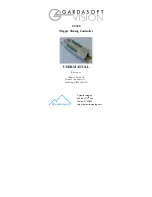
Each output also has the following flags which specify other options. For Ethernet commands,
multiple flags can be set by adding the flag values together.
Flag
value
Flag
Name
Operation
when flag = 0
Operation
when flag = 1
1
I
Trigger off leading edge of
input.
Trigger off trailing edge of
input.
2
O
Output is normally low,
going high when pulsing.
Output is inverted. It is
normally high, going low
when pulsing.
4
G
If a gate input is specified,
the input must be high to
enable triggers.
If a gate input is specified, the
input must be low to enable
triggers.
8
E
No Ethernet message.
Send message on Ethernet
when triggered.
16
F
Triggers are ignored until
output pulse is complete.
FIFO output mode. Multiple
triggers are queued up.
32
R
Resync mode disabled.
Resync Mode enabled.
64
P
Default to pulse in resync
mode.
Default to no pulse in resync
mode.
6.2.1
Burst Mode
In burst mode, an output is pulsed several times in response to a trigger. The periods are timed
(not encoder counts).
The following parameters are used:
•
Mode is 8 for burst mode
•
Gate Input specifies the number of pulses (1 to 250)
•
Pulse Width specifies the pulse width
•
Pulse Delay specifies the separation between the start of one pulse and the start of the next
Pulse Delay must be longer than Pulse Width.
6.2.2
Ethernet Message Flag (E)
When the CC320 is used to trigger a camera, the image processing can either be triggered by the
acquisition of an image or by an Ethernet message sent from the CC320.
When a trigger is received it is assigned a unique tag number (an incrementing number from 0 to
255). Using the GT Ethernet command and the Ethernet Message flag, the CC320 sends the tag
number in a message to the host computer to say that a trigger has occurred.
The message has the form:













































